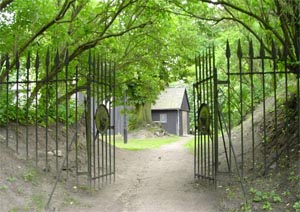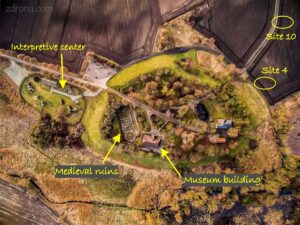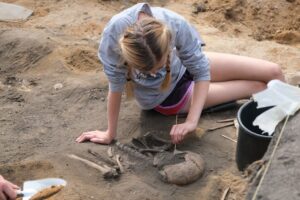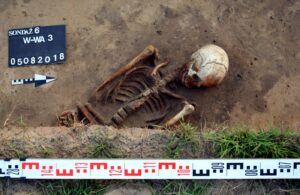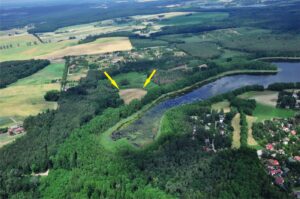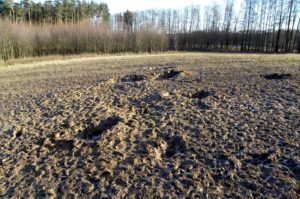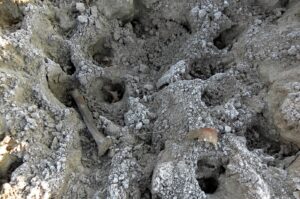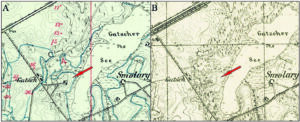Slavia Field School in Mortuary Archaeology, Giecz, Poland
For 10 years (1999-2008) Giecz Archaeological Complex has been a training ground for many international anthropology students who tirelessly mastered their practical skills in osteology and archaeology helping out at the Slavia excavations of the 12th century inhumation cemetery, commonly known as Giecz, site 4. Since then, many of these people have successfully pursued their careers in forensic sciences, bioarchaeology, or archaeology. Some of them have become university professors.
Now, the Slavia Field School in Mortuary Archaeology is pleased to invite new generations of anthropology students for a new joint effort at site 10 in Giecz. This site, which was discovered three years ago, is another inhumation cemetery and dates back to the beginning of the 11th century AD. Two pilot excavation seasons revealed 35 burials following the Christian rite, with bodies oriented east- west. The human remains feature very good preservation and include skeletons of both sexes and all age categories including newborns. Most burials have a variety of grave goods typical for western Slavs, and some are outstandingly well furnished. Among every day utensils such as iron knives, hardware fittings, and clay vessels, some graves have jewelry and decorations such as earrings, metal and glass rings, glass and carnelian bead necklaces. Some of the dead are even equipped with wooden buckets! Clearly this cemetery represents a spectrum of the local community’s social stratification. It cannot be ruled out that the richest graves belong to members of the Piast royal elite.
The Slavia Project, Mortuary Archaeology Field School in Giecz welcomes all students wishing to gain practical experience in excavating human remains and other aspects of mortuary archaeology. We are looking forward to your input in the search for yet undiscovered secrets of this site and will be happy to work with you. As the cemetery is located on an agricultural field and is subject to destructive deep plowing, your work will not only give you hands-on experience, but also the satisfaction of conserving and protecting an exceptional historical site. At the moment, the only way to preserve this unique treasure of Polish heritage is to meticulously investigate and document it. We hope you will help us to get this job done.
The very dry year of 2018 in the Wielkopolska region brought favourable conditions for archaeological aerial reconnaissance. Air photographs taken in the Zielonka Forest Landscape Park depicted a number of crop marks aligned in a distinct pattern indicating the presence of the remains of a vanished medieval village, Gać, located only 3 km from the vanished medieval town of Dzwonowo (see „Vanished towns and villages”).
Archaeological testing which followed the aerial reconnaissance confirmed the existence of the remnants of the village. At the height of its development, Gać had at least a dozen houses and a church. So far, a medieval cemetery and nearly 150 metal artefacts have been found there, including coins. The burial place was adjacent to a church established in the 14thcentury and operating until the mid-16thcentury AD. The excavation uncovered.
As research focusing on this topic is rare, there is very little data on the late medieval populations of Poland. In Gać, we would like to build a dataset which would enable us to write osteobiographies of this forgotten population. We would appreciate your help in getting this work done. In return, we offer an exceptional opportunity to gain and/or master practical skills in bioarchaeology, archaeology, and human osteology. The Slavia Field School in Mortuary Archaeology invites anthropology and archaeology students as well as anyone interested in bioarchaeology to join us in archaeological excavations of the Gać cemetery. Besides the scientific aspects of the initiative, the site also needs archaeological intervention as it is currently subject to various destructive wildlife activity, particularly that of wild boars, which root up human bones to the surface of the site.
The first written records about the gentry village of Gać come from 1335 AD and relate to the building of the wooden parish church of St. Peter and Paul. Apart from Gać, the new parish included the following, nearby hamlets: Łopuchowo, Łoskoń, Wojnowo, Brzeźno, and Włókna. The village of Gać developed along a transregional trade route which was formed in the second half of the 14thcentury and connected Wielkopolska with the area of Gdańsk and the Baltic Sea. However, in the mid-16thcentury, the parish of Gać was terminated and the aforementioned villages with the exception of Włókna were joined to the parish of Długa Goślina. Later in the 16thcentury, the village church was no longer in operation, and in the following centuries, the locals used the one in the nearby Łopuchowo. The decline of the village was marked by a decreasing population. However, on the maps available from the turn of the 18thand the 19thcentury the village of Gać was still marked as a hamlet situated along a route running from south-west to north-east. Today the village no longer exists.
fourteen very well preserved.
Key information
In the summer of 2021, we offer seven weeks of bioarcheological exploration and practice at the early medieval sites of Giecz. The program is divided into two sessions:
- June 28 – July 21
- July 22 – August 14
The application deadline is rolling until ALL SPACES ARE FILLED. The number of places is limited. In order to get the Information Packet and the Application Form please visit here.

